park assist TOYOTA VERSO 2013 Owners Manual
[x] Cancel search | Manufacturer: TOYOTA, Model Year: 2013, Model line: VERSO, Model: TOYOTA VERSO 2013Pages: 616, PDF Size: 39.6 MB
Page 3 of 616

1
2
3
4
5
6
3
VERSO_WE_OM64550E_EURO5
ers
Headlight switch.................. 249
Fog light switch ................... 256
Windshield wipers and washer ..
257
Rear window wiper and washer .
262
2-4. Using other driving systems
Cruise control.................... 263
Speed limiter..................... 267
Toyota parking assist-sensor...
270
Driving assist systems ........ 278
Hill-start assist control......... 284
2-5. Driving information
Cargo and luggage ............. 286
Winter driving tips ............... 289
Trailer towing (except Morocco)
292
3-1. Using the air conditioning sys-
tem and defogger
Manual air conditioning system
302
Automatic air conditioning sys-
tem.................................. 307
Power heater..................... 314
Rear window and outside rear
view mirror defoggers ....... 316
3-2. Using the audio systemAudio system types.......... 318
Using the radio................. 324
Using the CD player......... 328
Playing back MP3 and WMA
discs............................... 333
Operating an iPod............ 339
Operating a USB memory 346
Optimal use of the audio sys-
tem................................. 353
Using the AUX port........... 355
Using the steering wheel audio
switches ........................... 356
3-3. Using the interior lights
Interior lights list ................. 359
• Personal/interior lights main
switch 360
• Personal/interior lights ..... 361
• Personal/interior lights ..... 362
3-4. Using the storage features
List of storage features....... 363
• Glove box ......................... 364
• Glove box and console box.....
365
• Console box and overhead
console 366
• Overhead console and cup
holders 367
• Cup holders and bottle holders
368
• Bottle holders and auxiliary
boxes 369
• Auxiliary boxes ................. 370
• Auxiliary boxes ................. 371
3-5. Other interior features
Sun visors .......................... 372
3Interior features
Page 15 of 616
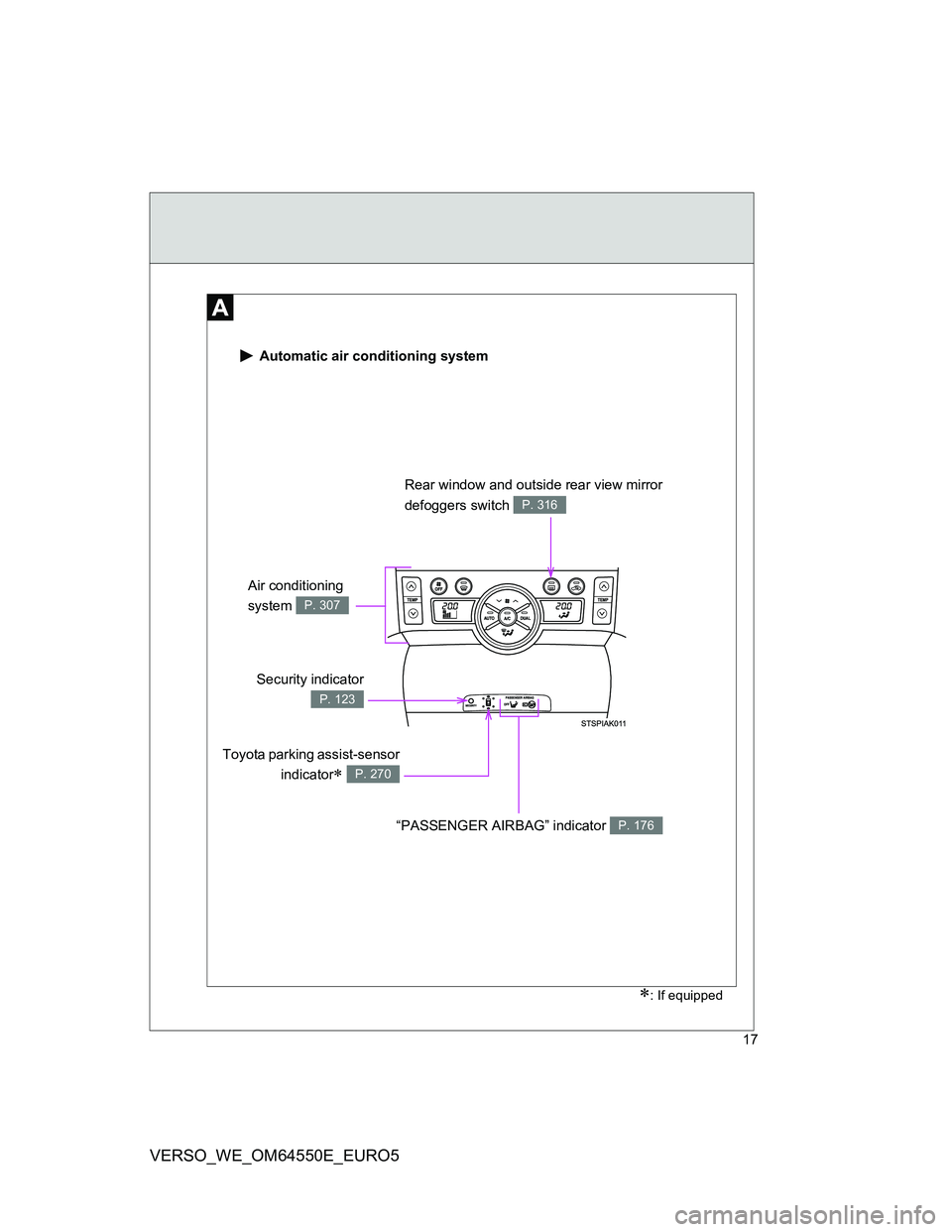
17
VERSO_WE_OM64550E_EURO5
Automatic air conditioning system
Security indicator
P. 123
Rear window and outside rear view mirror
defoggers switch
P. 316
“PASSENGER AIRBAG” indicator P. 176
Air conditioning
system
P. 307
Toyota parking assist-sensor
indicator
P. 270
: If equipped
Page 17 of 616
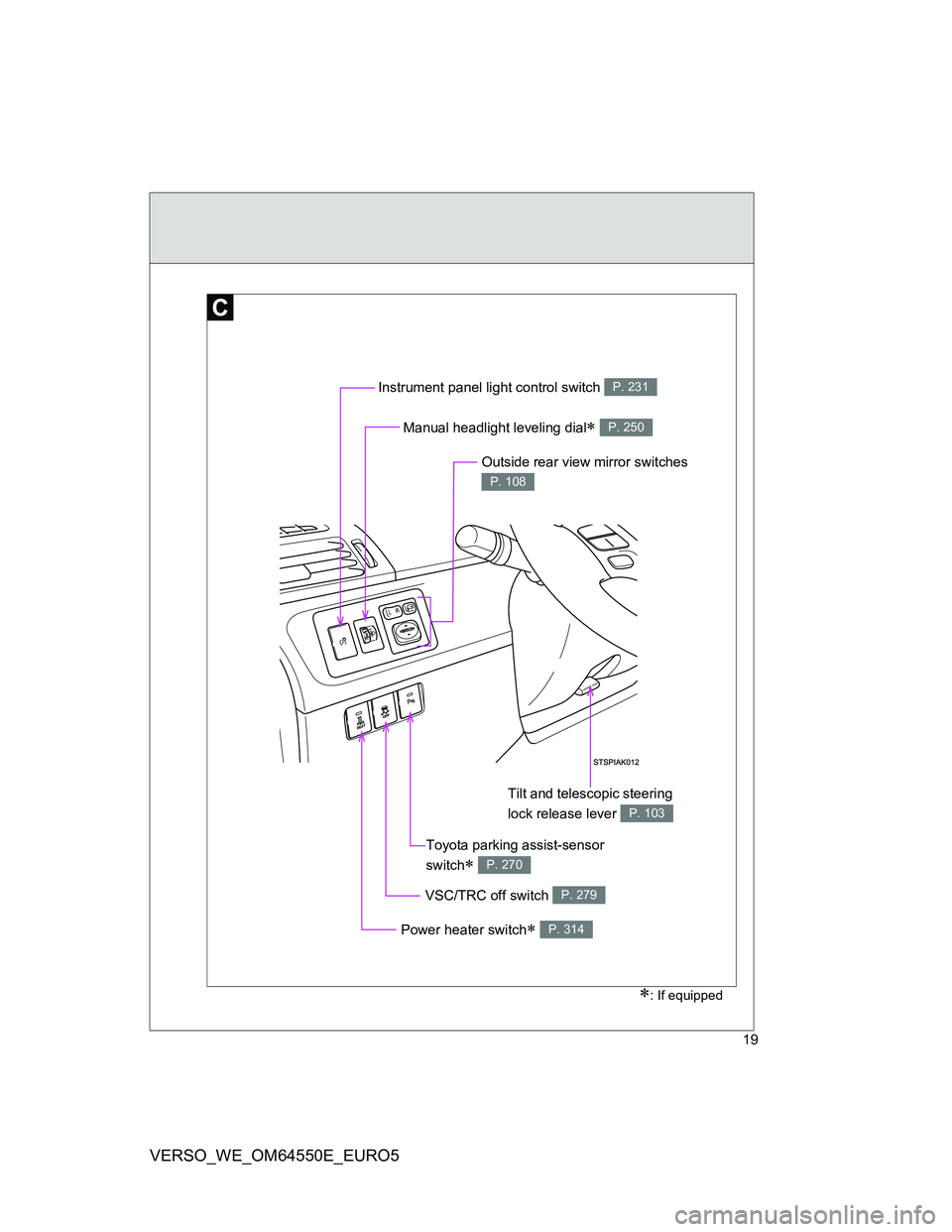
19
VERSO_WE_OM64550E_EURO5
Manual headlight leveling dial P. 250
Power heater switch P. 314
Outside rear view mirror switches
P. 108
VSC/TRC off switch P. 279
Tilt and telescopic steering
lock release lever
P. 103
Toyota parking assist-sensor
switch
P. 270
Instrument panel light control switch P. 231
: If equipped
Page 181 of 616
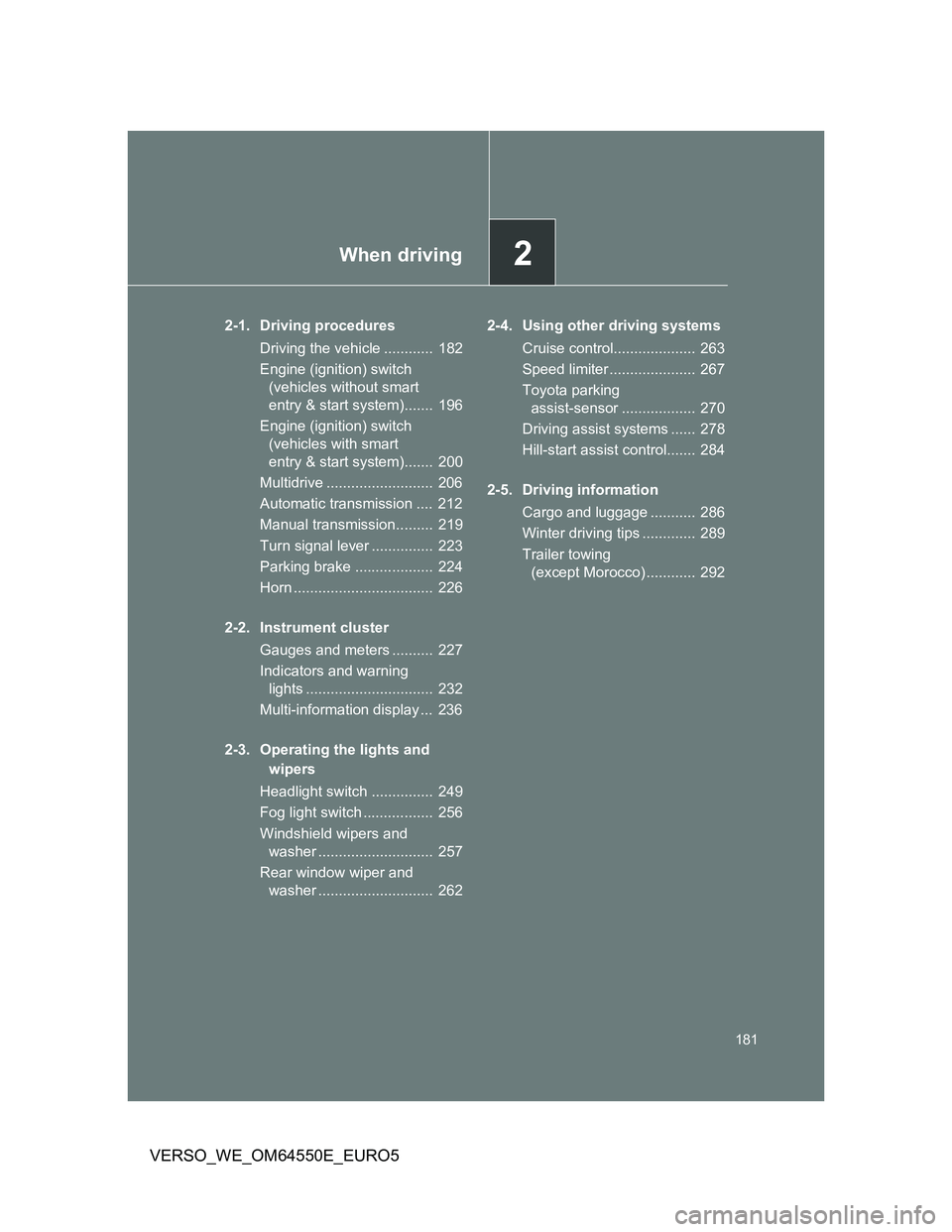
2When driving
181
VERSO_WE_OM64550E_EURO5
2-1. Driving procedures
Driving the vehicle ............ 182
Engine (ignition) switch
(vehicles without smart
entry & start system)....... 196
Engine (ignition) switch
(vehicles with smart
entry & start system)....... 200
Multidrive .......................... 206
Automatic transmission .... 212
Manual transmission......... 219
Turn signal lever ............... 223
Parking brake ................... 224
Horn .................................. 226
2-2. Instrument cluster
Gauges and meters .......... 227
Indicators and warning
lights ............................... 232
Multi-information display ... 236
2-3. Operating the lights and
wipers
Headlight switch ............... 249
Fog light switch ................. 256
Windshield wipers and
washer ............................ 257
Rear window wiper and
washer ............................ 2622-4. Using other driving systems
Cruise control.................... 263
Speed limiter ..................... 267
Toyota parking
assist-sensor .................. 270
Driving assist systems ...... 278
Hill-start assist control....... 284
2-5. Driving information
Cargo and luggage ........... 286
Winter driving tips ............. 289
Trailer towing
(except Morocco) ............ 292
Page 184 of 616

184 2-1. Driving procedures
VERSO_WE_OM64550E_EURO5
Starting on a steep uphill
Multidrive or automatic transmission
Firmly set the parking brake and shift the shift lever to “D” or
“M”.
Gently depress the accelerator pedal.
Release the parking brake.
Manual transmission
With the parking brake set and the clutch pedal fully
depressed, shift the shift lever to “1”.
Lightly depress the accelerator pedal at the same time as
gradually releasing the clutch pedal.
Release the parking brake. (P. 224)
Hill-Start Assist Control
The hill-start assist control allows you to smoothly start off the vehicle on a
steep or slippery uphill incline. (P. 284)
Driving in the rain
Drive carefully when it is raining, because visibility will be reduced, the
windows may become fogged-up, and the road will be slippery.
Drive carefully when it starts to rain, because the road surface will be
especially slippery.
Refrain from high speeds when driving on an expressway in the rain,
because there may be a layer of water between the tires and the road
surface, preventing the steering and brakes from operating properly.
Page 188 of 616
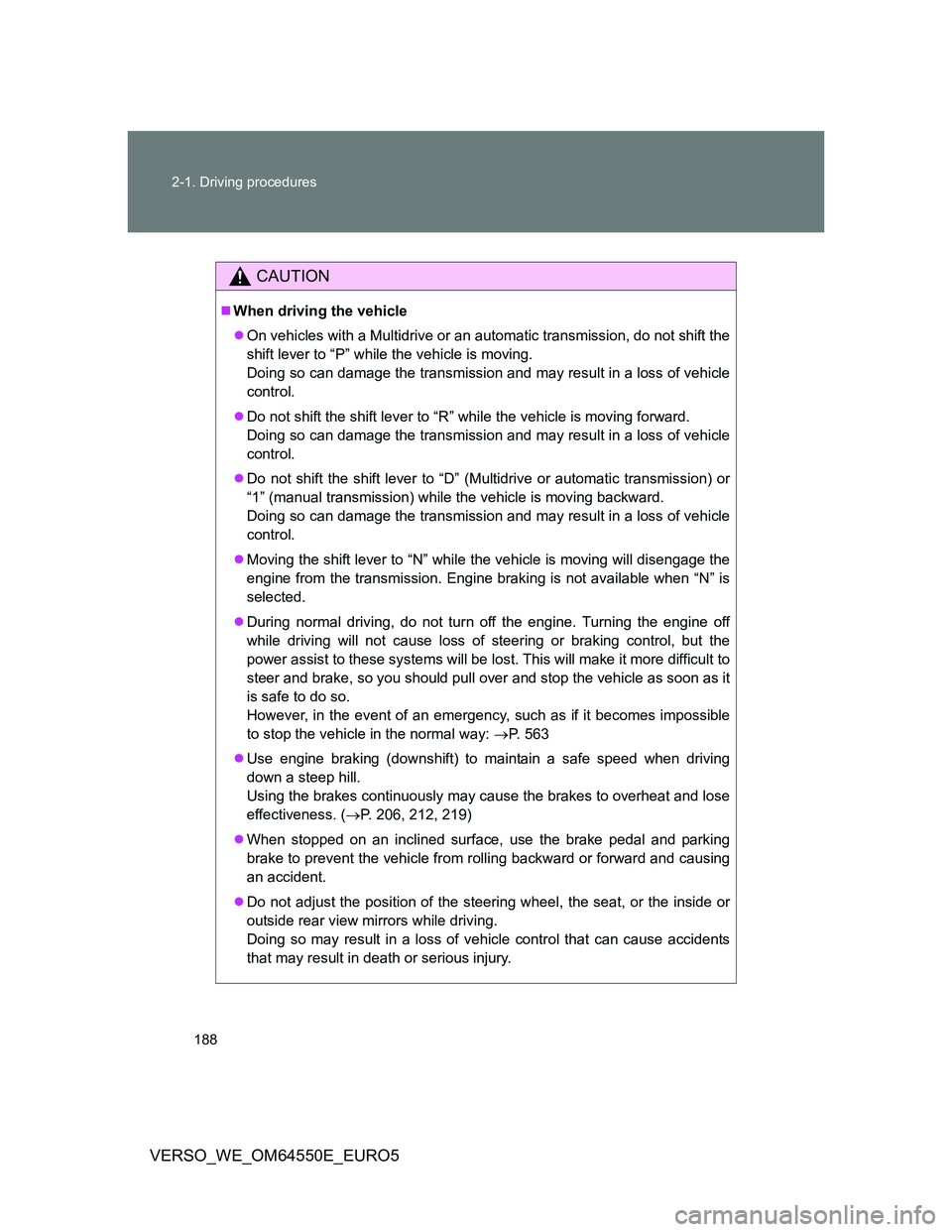
188 2-1. Driving procedures
VERSO_WE_OM64550E_EURO5
CAUTION
When driving the vehicle
On vehicles with a Multidrive or an automatic transmission, do not shift the
shift lever to “P” while the vehicle is moving.
Doing so can damage the transmission and may result in a loss of vehicle
control.
Do not shift the shift lever to “R” while the vehicle is moving forward.
Doing so can damage the transmission and may result in a loss of vehicle
control.
Do not shift the shift lever to “D” (Multidrive or automatic transmission) or
“1” (manual transmission) while the vehicle is moving backward.
Doing so can damage the transmission and may result in a loss of vehicle
control.
Moving the shift lever to “N” while the vehicle is moving will disengage the
engine from the transmission. Engine braking is not available when “N” is
selected.
During normal driving, do not turn off the engine. Turning the engine off
while driving will not cause loss of steering or braking control, but the
power assist to these systems will be lost. This will make it more difficult to
steer and brake, so you should pull over and stop the vehicle as soon as it
is safe to do so.
However, in the event of an emergency, such as if it becomes impossible
to stop the vehicle in the normal way: P. 563
Use engine braking (downshift) to maintain a safe speed when driving
down a steep hill.
Using the brakes continuously may cause the brakes to overheat and lose
effectiveness. (P. 206, 212, 219)
When stopped on an inclined surface, use the brake pedal and parking
brake to prevent the vehicle from rolling backward or forward and causing
an accident.
Do not adjust the position of the steering wheel, the seat, or the inside or
outside rear view mirrors while driving.
Doing so may result in a loss of vehicle control that can cause accidents
that may result in death or serious injury.
Page 192 of 616
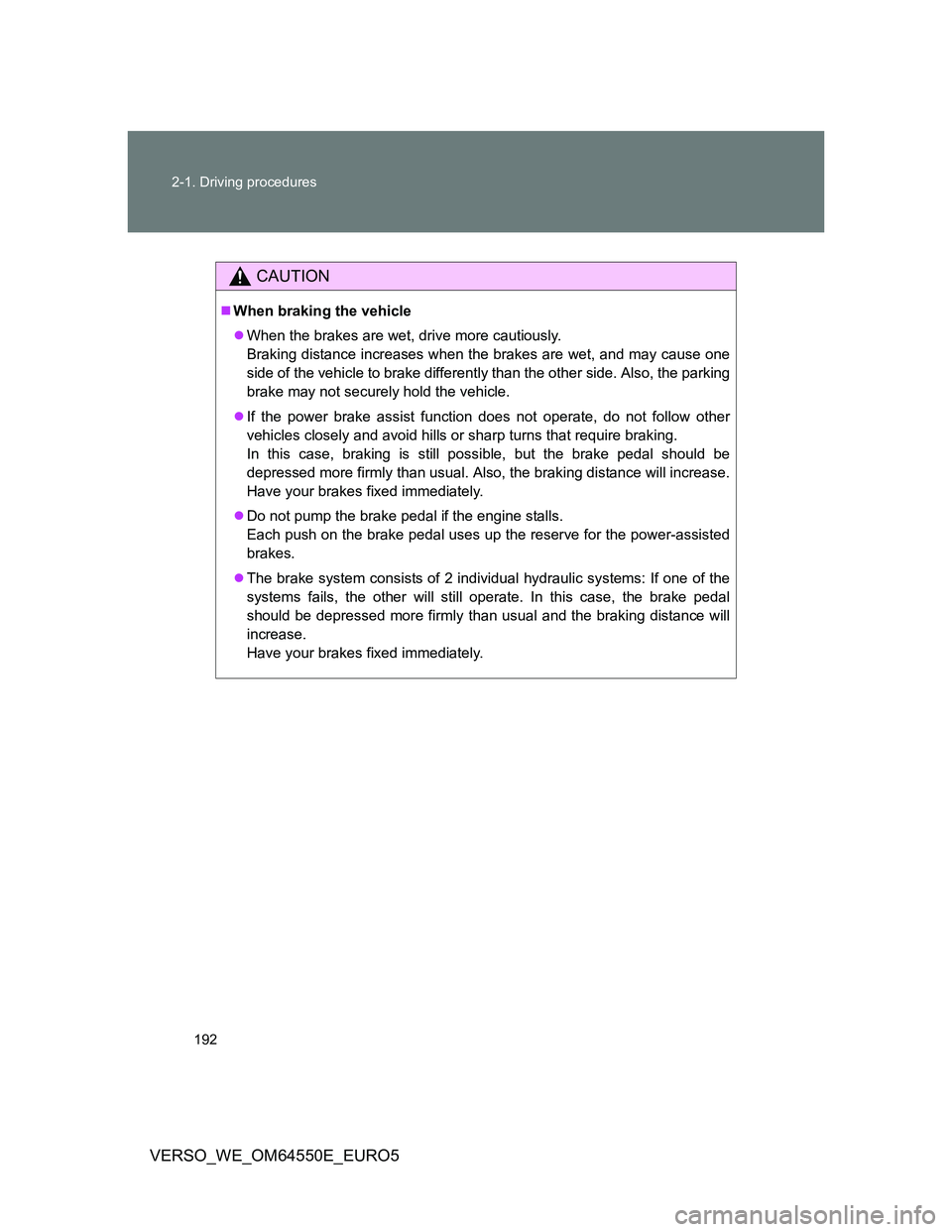
192 2-1. Driving procedures
VERSO_WE_OM64550E_EURO5
CAUTION
When braking the vehicle
When the brakes are wet, drive more cautiously.
Braking distance increases when the brakes are wet, and may cause one
side of the vehicle to brake differently than the other side. Also, the parking
brake may not securely hold the vehicle.
If the power brake assist function does not operate, do not follow other
vehicles closely and avoid hills or sharp turns that require braking.
In this case, braking is still possible, but the brake pedal should be
depressed more firmly than usual. Also, the braking distance will increase.
Have your brakes fixed immediately.
Do not pump the brake pedal if the engine stalls.
Each push on the brake pedal uses up the reserve for the power-assisted
brakes.
The brake system consists of 2 individual hydraulic systems: If one of the
systems fails, the other will still operate. In this case, the brake pedal
should be depressed more firmly than usual and the braking distance will
increase.
Have your brakes fixed immediately.
Page 234 of 616
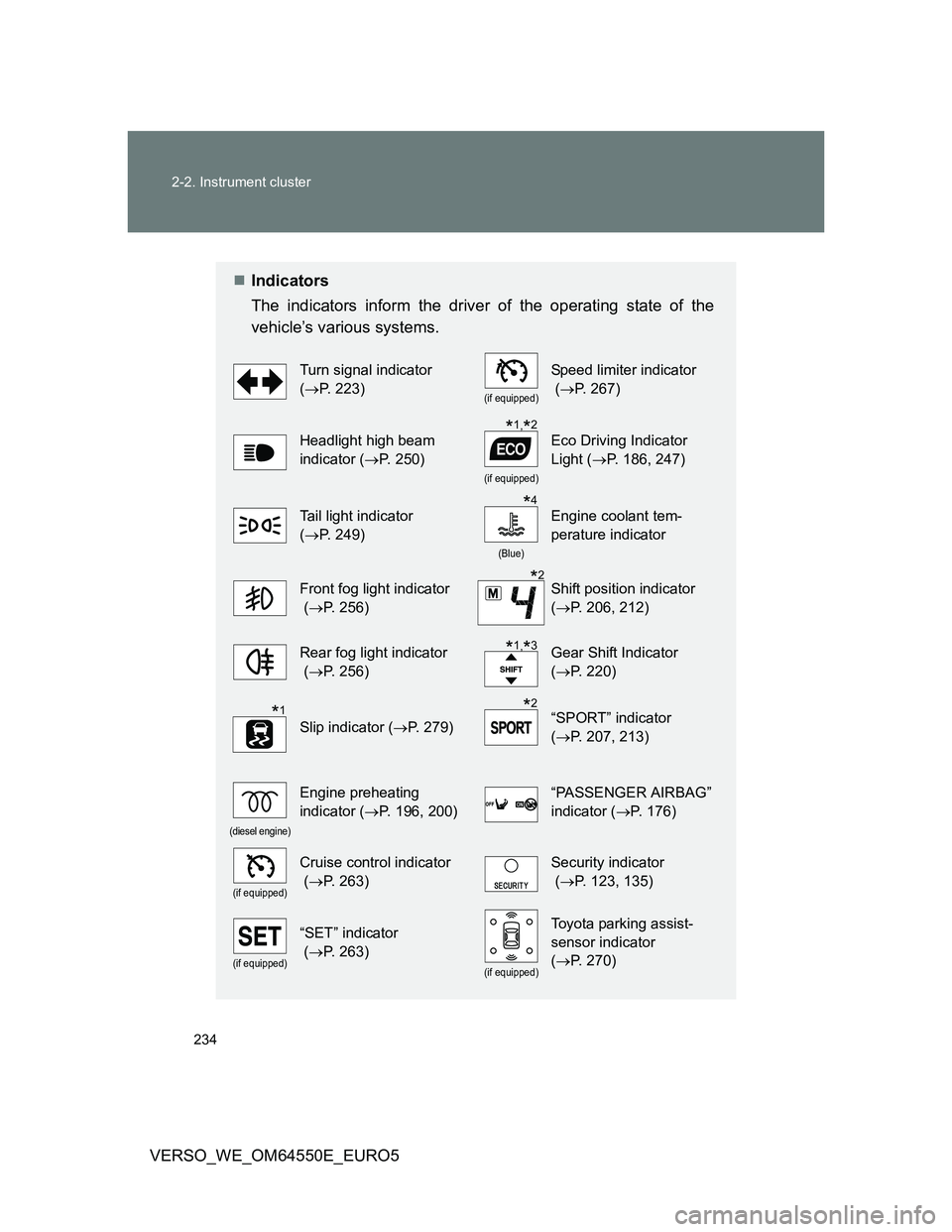
234 2-2. Instrument cluster
VERSO_WE_OM64550E_EURO5
Indicators
The indicators inform the driver of the operating state of the
vehicle’s various systems.
Turn signal indicator
(P. 223)
(if equipped)
Speed limiter indicator
(P. 267)
Headlight high beam
indicator (P. 250)
(if equipped)
Eco Driving Indicator
Light (P. 186, 247)
Tail light indicator
(P. 249)
(Blue)
Engine coolant tem-
perature indicator
Front fog light indicator
(P. 256)Shift position indicator
(P. 206, 212)
Rear fog light indicator
(P. 256)Gear Shift Indicator
(P. 220)
Slip indicator (P. 279)“SPORT” indicator
(P. 207, 213)
(diesel engine)
Engine preheating
indicator (P. 196, 200)“PASSENGER AIRBAG”
indicator (P. 176)
(if equipped)
Cruise control indicator
(P. 263)Security indicator
(P. 123, 135)
(if equipped)
“SET” indicator
(P. 263)
(if equipped)
Toyota parking assist-
sensor indicator
(P. 270)
*1,*2
*4
*2
*1,*3
*1*2
Page 270 of 616

270
2-4. Using other driving systems
VERSO_WE_OM64550E_EURO5
Toyota parking assist-sensor
: If equipped
The distance from your vehicle to nearby obstacles when parallel
parking or maneuvering into a garage is measured by the sensors
and communicated via an indicator and a buzzer. Always check the
surrounding area when using this system.
Types of sensors
Front corner sensors
Front center sensors
Rear corner sensors
Rear center sensors
Toyota parking assist-sensor switch
Turns the Toyota parking
assist-sensor on/off
When on, the indicator light
comes on to inform the driver
that the system is operational.
Page 271 of 616

271 2-4. Using other driving systems
2
When driving
VERSO_WE_OM64550E_EURO5
Display
When the sensors detect an obstacle, the Toyota parking assist-sen-
sor indicator is illuminated by an LED depending on position and dis-
tance to the obstacle.
Front center sensor operation
Front corner sensor operation
Vehicle indicator
Rear corner sensor operation
Rear center sensor operation
The distance display and buzzer
When a sensor detects an obstacle, the direction of and the approxi-
mate distance to the obstacle are displayed and the buzzer sounds.
Sensor operation and distance to an obstacle
The system operates when the vehicle approaches an obstacle, as
shown by the following table.